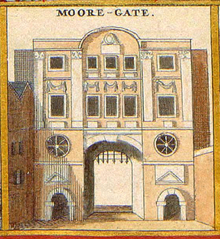
Back Μούρφιλντς Greek Moorfields Spanish Moorfields French Moorfields Irish Moorfields Italian Мурфилдс Russian Moorfields Swedish Moorfields Turkish
51°31′05″N 0°05′19″W / 51.518188°N 0.088611°W


Moorfields was an open space, partly in the City of London, lying adjacent to – and outside – its northern wall, near the eponymous Moorgate. It was known for its marshy conditions, the result of the defensive wall acting as a dam, impeding the flow of the River Walbrook and its tributaries.[1]
Moorfields gives its name to the Moorfields Eye Hospital which occupied a site on the former fields from 1822–1899, and is still based close by, in the St Luke's area of the London Borough of Islington.[2]
- ^ On the wall eventually becoming an unintended? dam holding back the Walbrook https://www.british-history.ac.uk/rchme/london/vol3/pp10-18
- ^ History from the hospital's own web page https://www.moorfields.nhs.uk/content/our-history
© MMXXIII Rich X Search. We shall prevail. All rights reserved. Rich X Search